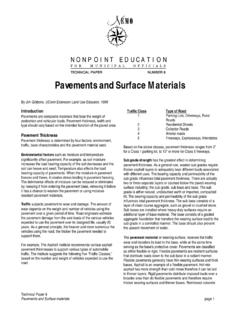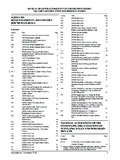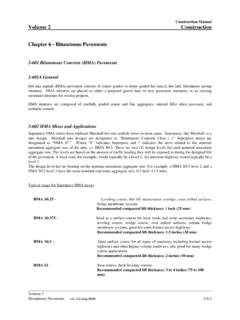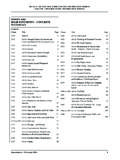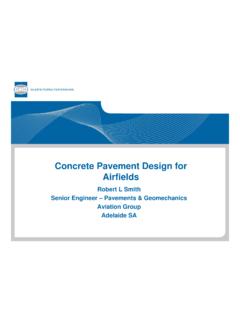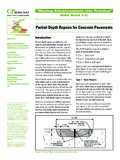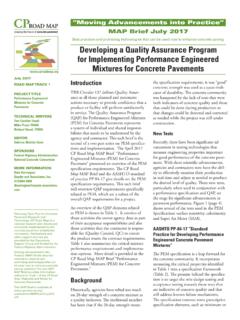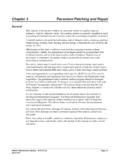Transcription of Pavements and Surface Materials - CT NEMO …
1 Technical Paper 8 Pavements and Surface Materials page 1 N O N P O I N T E D U C A T I O N F O R M U N I C I P A L O F F I C I A L S TECHNICAL PAPER NUMBER 8 Pavements and Surface Materials By Jim Gibbons, UConn Extension Land Use Educator, 1999 Introduction Pavements are composite Materials that bear the weight of pedestrian and vehicular loads. pavement thickness, width and type should vary based on the intended function of the paved area.
2 pavement Thickness pavement thickness is determined by four factors: environment, traffic, base characteristics and the pavement material used. Environmental factors such as moisture and temperature significantly affect pavement . For example, as soil moisture increases the load bearing capacity of the soil decreases and the soil can heave and swell. Temperature also effects the load bearing capacity of Pavements . When the moisture in pavement freezes and thaws, it creates stress leading to pavement heaving. The detrimental effects of moisture can be reduced or eliminated by: keeping it from entering the pavement base, removing it before it has a chance to weaken the pavement or using moisture resistant pavement Materials . Traffic subjects pavement to wear and damage. The amount of wear depends on the weight and number of vehicles using the pavement over a given period of time.
3 Road engineers estimate the pavement damage from the axle loads of the various vehicles expected to use the pavement over its designed life, usually 20 years. As a general principle, the heavier and more numerous the vehicles using the road, the thicker the pavement needed to support them. For example, The Asphalt Institute recommends various asphalt pavement thicknesses to support various types of automobile traffic. The Institute suggests the following five Traffic Classes, based on the number and weight of vehicles expected to use the road: Traffic Class Type of Road 1 Parking Lots, Driveways, Rural Roads 2 Residential Streets 3 Collector Roads 4 Arterial roads 5 Freeways, Expressways, Interstates Based on the above classes, pavement thickness ranges from 3" for a Class 1 parking lot, to 10" or more for Class 5 freeways.
4 Sub grade strength has the greatest effect in determining pavement thickness. As a general rule, weaker sub grades require thicker asphalt layers to adequately bear different loads associated with different uses. The bearing capacity and permeability of the sub grade influences total pavement thickness. There are actually two or three separate layers or courses below the paved wearing Surface including: the sub grade, sub base and base. The sub grade is either natural, undisturbed earth or imported, compacted till. The bearing capacity and permeability of the sub grade influences total pavement thickness. The sub base consists of a layer of clean course aggregate, such as gravel or crushed stone. Sub bases are installed where heavy-duty surfaces require an additional layer of base material . The base consists of a graded aggregate foundation that transfers the wearing Surface load to the sub grade in a controlled manner.
5 The base should also prevent the upward movement of water. The pavement material or wearing Surface , receives the traffic wear and transfers its load to the base, while at the same time serving as the base's protective cover. Pavements are classified as either flexible or rigid. Flexible Pavements are resilient surfaces that distribute loads down to the sub base in a radiant manner. Flexible Pavements generally have thin wearing surfaces and thick bases. Asphalt is an example of a flexible pavement . Hot mix asphalt has more strength than cold mixes therefore it can be laid in thinner layers. Rigid Pavements distribute imposed loads over a broader area than do flexible Pavements and therefore require thicker wearing surfaces and thinner bases. Reinforced concrete Technical Paper 8 Pavements and Surface Materials page 2 slabs and paver stone embedded in reinforced concrete are examples of rigid pavement .
6 The Asphalt Institute in College Park, Maryland has issued a Asphalt Thickness and Design, manual that suggests that asphalt thickness for roads be based on the following three factors: 1. Traffic weight and number of vehicles that will use the road 2. Strength of proposed sub base, and, 3. pavement material to be used. pavement Width As with thickness, pavement width should vary based on its intended use. Interstate highways will obviously need to be much wider than local residential roads. Similarly, the parking lot serving a regional shopping center will be much larger than one for a neighborhood convenience store. A sidewalk in a low-density residential area can be narrower than one serving a central business district. While the relationship of width to intended use seems so logical, many communities still have a one design fits all occasions approach to pavement widths.
7 pavement width standards are often found in local land use regulations. Zoning and subdivision regulations generally contain minimum width requirements for roads, driveways, sidewalks, parking stalls, loading areas, emergency access ways, alleys and multi-use trails. Developers often install pavement far exceeding minimum standards. The over-paving of the developed landscape has well documented adverse environmental, social, and economic consequences. The direct adverse relationship between a watershed's imperviousness and its water quality is well established. As we pave the Earth's Surface , we disrupt natural drainage and infiltration systems, drastically altering land and water as well as people and wildlife whose lives depend on the health of these resources. People are concerned that landscape design often pays more attention to the paved areas serving the automobile, than to green areas serving man and wildlife.
8 Local officials are beginning to better understand the costs associated with the design, installation and maintenance of paved areas. It is one thing to require developers to install expansive roads, curb and curtain drain systems, it is another for municipalities to provide the resources to own and properly maintain these areas once they are built. pavement material Asphalt and concrete are the most common paving Materials found in the developed landscape. However, there are other strong, durable Pavements that can add variety to the built landscape and help reduce pavement 's imperviousness. The following is a review of selected paving Materials : 1. Asphault Bituminous concrete or asphalt is composed of aggregates bound together with asphalt cement. The aggregate is heated and mixed with hot (275 f) asphalt cement then taken to the construction site where it is placed, as a wearing Surface , over a base course.
9 The asphalt is laid by hand or paving machine, then rolled to force the mixture to firmly set. It is then allowed to cool. Depending on: how it is constructed, the traffic it will bear, the climate it must endure, and the maintenance it receives, typical asphalt pavement has a life expectancy of 20 years before it needs resurfacing. Bituminous surfaces when properly installed are: durable, can be used year round, drain quickly, are comparatively easy and inexpensive to maintain, resilient, hard, firm, easily marked, dust free, neat, non-glare and can be used for many different activities. The disadvantages of bituminous surfaces are their relatively high installation costs and their imperviousness. Asphalt can be mixed with cork, sponge or rubber to create more resilient surfaces or with crushed stone to produce a hard or more porous Surface .
10 Asphalt pavement is composed of the following two layers, the wearing course and the base course: The Wearing Course transfers and distributes traffic loads to the base course. The wearing course is actually composed of two layers, a 1-1/4" to 1-1/2" Surface layer and a 3" bonding layer. The bonding course penetrates voids in the sub base and binds the wearing course to the sub base aggregate. The thickness of the wearing course varies according to intended use, the Materials used and the bearing strength of the sub base. The Base Course thickness might range from 6" to 18" depending on the designed use and the bearing strength of material used. If the material has low bearing strength, sub base thickness is increased or stronger Materials used. The thinnest applications of asphalt involve the spreading of a liquid mix on gravel roads to provide water and dust proofing while at the other end of the thickness scale, some roads may require 10" or more of asphalt to support projected traffic.
